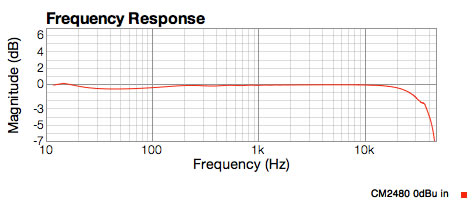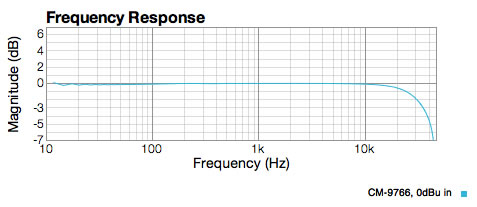The Book of Laminations
Chapter II,

Master Track (no transformer processing)
This is the raw Mono track in Mp3 format at 256Kbps bounced directly from the DAW. We chose it because it has a solid Bass, a vocal section for midrange and mandolin for some high frequency sounds to listen for.
Original song: "Brave Enough" by Juie Rains (iTunes)
Produced and engineered at 3rd Floor Studios by Brian Fox
Important Note:
The graphs below plot out to 45,000 Hz. Human hearing at its best only goes to 20,000, which is the first line in the graphs after the 10K mark. The roll off after 25,000 is mainly due to the Apogee ensemble's internal filter.
Transformer 1

Notice the saddle below 100Hz, this is the transformer struggling just a little with the Bass frequencies at this level. (it's only a 0.5 dB dip remember) And the bump at 15Hz is the capacitor and the transformer "ringing" in "resonance" at this frequency. Choosing a bigger capacitor pushes the resonance point lower and would actually REDUCE the bass response.
Transformer 2

Apex has a little more juice at 20K than the Cinemag 2480 and almost a dB more energy at 30KHz. When you listen perhaps you understand why our "Basic" upgrade for the APEX 460 does not require a new transformer. This little guy holds up very well against some of the name brands.
Transformer 3

Studio projects used a larger nickel alloy core but it has essentially the same curve as the Alctron (APEX) transformer. The bigger core give you more headroom (higher output without distortion) at Bass frequencies.
Transformer 4
Big core Cinemag 9766 has no troubles with Bass! This is because it is a 12:1 ratio and doesn't over load our 22K tube simulator. And the resonance is way below 10Hz, effectively out of the picture.
Transformer 5

The smaller core of the T14 thins out the bottom end when we hit it with this much level. See the resonance with the 1uF cap is at 22Hz and below that the signal falls off quickly. The high end is better than all the others and the upper mids are pushed .1 or .2 dB about 4K. This gives mics with this transformer a "clean" sounding low end and a bit of sparkle on top.
Now listen to the track. Do your ears hear what the graph is showing, when you compare it to the master track?
Conclusions
It seems to our ears that that transformer is not the biggest part of shaping the sound of a microphone. It is has nowhere near as big an influence as say, a capsule change, but it does contribute things to broad areas of the sound spectrum. These contributions then make up part of the total sound of the microphone.
This may seem obvious but we read on the web about so many people trying to improve their microphone by simply changing the transformer. It seems clear from these results that a new transformer by itself, will not fix a microphone that sounds bad. It will simply change the nature of the "bad" sound.
To really improve a microphone we need to understand the role the transformer plays in the overall sound and choose it to support our goals for the microphone but then also know that the transformer is not the whole story.
If you have any comments for us send them to :

